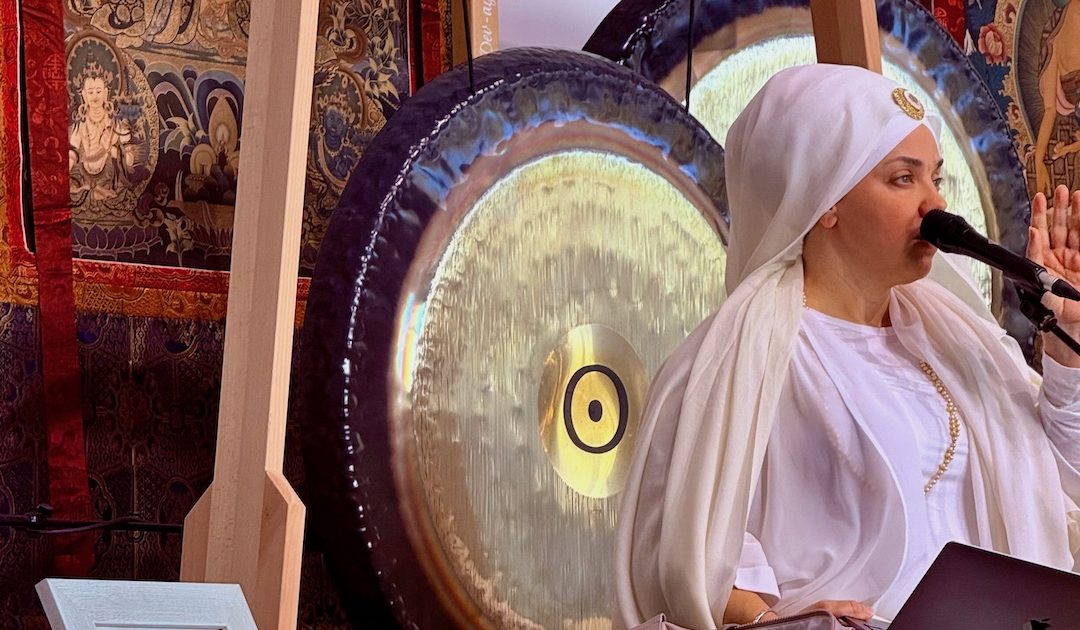In my recent Kundalini Yoga Teacher Training, I experienced firsthand the profound and transformative role sound plays in spiritual growth, emotional healing, and connection to higher consciousness. I’ve since reflected on how this ancient wisdom parallels modern science’s understanding of sound as a tool for healing.
For this part of the curriculum, I was lucky enough to be taught by Gurujas Khalsa, lead singer of the Grammy Award-winning band White Sun who have put many kundalini yoga mantras to music. Their music has been used both to study stress management and also in scientific studies at UCLA’s Neuropsychiatric Hospital.
This post shares insights from my journey, highlighting the mystical power of sound and its relevance not only in Kundalini Yoga but also in modern Western approaches to wellness.
Sound as a Tool for Energetic Transformation
One of the most powerful lessons I learned during the training was that sound is not just something you hear—it’s something you feel, and it has the capacity to shift your entire energetic state. We experience sound waves as they penetrate the body as well as through what we hear.
When we chant in kundalini yoga we focus on the vibrations we feel in our body and through the cavities in the skull as we hear the sound that we produce.
There are 84 meridian points in the roof of the mouth which are stimulated by movement of the tongue and chanting – thus stimulating the secretion of various chemical messengers which in turn can impact the chemical composition of the brain, stimulating the hypothalamus, and the pineal and pituitary glands. This is why even though we may not understand the words we are using when chanting mantras (as they’re generally in Sanskrit language), we are still benefitting from them though the physical pronunciation we do. I realised how important it was to get the pronunciation right!
The Mysticism of the Gong and Sacred Sounds
One unforgettable experience was the deep immersion in gong meditation. The teachers explained that the gong produces a full spectrum of sound frequencies, capable of penetrating the subconscious mind and clearing energetic blockages.
Lying down during the sessions, I could feel the vibrations ripple through my body. The sound was both grounding and otherworldly, and behind my closed eyes I also saw colours and patterns which pulsated in rhythm with the sound waves of the gong.
It was a profound reminder that sound has the power to heal not just the physical body but also the mind and spirit.
The Science of Sound Healing in the Western World
What fascinated me was how this ancient understanding of sound aligns with modern medical science. In hospitals, sound waves are used for various healing applications, including ultrasound technology for imaging and high-frequency sound waves to break down kidney stones.
These practices illustrate that sound is not just mystical; it’s also scientifically validated as a powerful healing tool. The vibrations generated by sound can affect physical matter—just as the gong’s vibrations seemed to shift my internal state during meditation.
Your Own Voice as the Most Powerful Sound
One of the most transformative lessons from the training was the realization that your own voice is so much more powerful than any other sound. This is why chanting using your own voice is essential. When you chant, you generate vibrations that are uniquely attuned to your body and energetic system.
We discussed the concept that we all have our own unique ‘key note’ – I’m going to clumsily describe this as a pitch of sound that is uniquely our own, and when we identify and use it we are able to create great power in the sound that we make without requiring great volume. With some experimentation in these teaching sessions I began to hear my own key note within me. I realised that even though the people next to me could be chanting very loudly, when I used this keynote, even at low volumes I was able to hear my own sound very easily above all others.
I noticed a profound difference between simply listening to a mantra and actively chanting it myself. When I used my own voice, the resonance felt deeply personal and healing. It was as though my own sound became a bridge between my inner self and the divine.
Mantras and Collective Sound
Chanting in a group amplified the experience even further. There was a sense of collective vibration that united us as a community. The sound waves created by our voices intertwined, creating a tapestry of energy that was both grounding and elevating.
This collective chanting brought moments of pure joy and transcendence. It was a reminder that sound has the power not only to heal individuals but also to connect us to each other.
Insights to Carry Forward
The training changed my relationship with sound in profound ways. I now appreciate how intentional sound can be a powerful tool for daily life – whether it’s through chanting a mantra to ground myself, listening to calming music, or simply being mindful of the sounds around me.
If you’re new to chanting, I encourage you to experiment with using your own voice. Start with simple mantras and notice how the vibrations affect your state of mind and energy. Remember, your voice holds immense power – far beyond what you might imagine.
Final Reflection: A Journey Through the Mysticism of Sound
My experience during Kundalini Yoga Teacher Training was a beautiful reminder that sound is far more than a sensory experience. It is a mystical and scientific force that can heal, transform, and connect us to something greater than ourselves.
Whether through ancient mantras or modern medical technology, sound continues to be a bridge between the seen and unseen, the physical and the spiritual. I invite you to explore its transformative power for yourself and discover the magic of your own voice.

